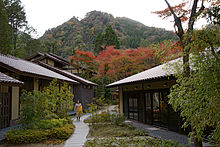- Ryokan (Japanese inn)
-
For other uses, see Ryokan (disambiguation).
 Ryokan (Arima Onsen)
Ryokan (Arima Onsen)
A ryokan (旅館) is a type of traditional Japanese inn that originated in the Edo period (1603–1868), when such inns served travelers along Japan's highways. They typically feature tatami-matted rooms, communal baths, and other public areas where visitors may wear yukata and talk with the owner.[1]
Ryokan are difficult to find in Tokyo and other large cities because many are expensive compared to hotels, and Japanese people increasingly use hotels for urban tourism. Nonetheless, some major cities do have reasonably priced ryokan, with some costing as little as $40 a night. However, ryokan are more typically located in scenic areas, such as in the mountains or by the sea, and tend to be more expensive.[2]
Contents
Features
A typical ryokan has a relatively large entrance hall, with couches and chairs where guests can sit and talk; a modernized ryokan often has a television in the hall as well. Guest rooms are constructed using traditional Japanese methods: flooring is tatami, and doors are sliding doors. Even if the inn uses hinged doors for security, it usually opens into a small entranceway where guests can take off their shoes before stepping onto the tatami floor, which would be separated by a sliding door. Many ryokan rooms also feature a porch or balcony, also set off with a sliding door.
Almost all ryokan feature common bathing areas or ofuro, usually segregated by gender, using the water from a hot spring (onsen) if any are nearby. (Areas with natural hot springs tend to attract high concentrations of ryokan). High-end ryokan may provide private bathing facilities as well. Typically ryokan provide guests with a yukata to wear; they might also have games such as table tennis, and possibly geta that visitors can borrow for strolls outside.
Bedding is a futon spread out on the tatami floor. When guests first enter their room, they usually find a table and some supplies for making tea. The table is also used for meals when guests take them in their room. While guests are out, staff (usually called nakai) will move the table aside and set out the futon.
Meals
Most ryokan offer dinner and breakfast, which are often included in the price of the room. Most visitors do take their meals at the ryokan, which usually promote themselves on the quality of their food. Meals consist of traditional Japanese cuisine known as kaiseki, which features seasonal and regional specialties. (Kaiseki originally referred to light meals served during a tea ceremony, and today refers to a meal consisting of a number of small, varied dishes.) In order for each dish to be enjoyed at the proper temperature, ryokan stress that guests should be punctual for their meals. For this reason, most ryokan ask guests to confirm the time they want to take their meals.
Some ryokan have a communal dining area, but most serve meals in the guests' rooms. Ryokan which are likely to serve non-Japanese guests may also have a selection of Western food.
Minshuku
Minshuku (民宿) are a budget version of ryokan, roughly equivalent to a British boarding house or a bed and breakfast. The facilities are similar to a hotel or may simply consist of spare rooms in a family home. Minshuku often serve as the only type of accommodation in towns or villages too small to warrant a dedicated hotel or ryokan. The overall experience is much the same, but the food is simpler, dining may be optional and is often communal, rooms do not usually have a private toilet, and guests may have to lay out their own bedding.
See also
References
External links
Elements of Japanese architecture Styles Buddhist · Buke · Daibutsuyō · Gassho · Giyōfū · Hachiman · Hirairi · Hiyoshi (also called Hie) · Irimoya · Ishi-no-ma · Kasuga · Kibitsu · Nagare · Ōbaku Zen · Setchūyō · Shinden · Shinmei · Shinto · Shoin · Sukiya · Sumiyoshi · Taisha · Wayō · ZenshūyōA model of Himeji Castle
Building types Roof styles Structural Burdock piling · Chigi · Disordered piling · Engawa · Fusuma · Hisashi · Irimoya-zukuri · Irori · Jinmaku · Katōmado · Katsuogi · Kuruwa · Mokoshi · Moya · Nakazonae · Namako wall · Nightingale floor · Onigawara · Ranma · Shōji (see also washi) · Sōrin · Tamagaki · Tatami · Tokonoma · Tokyō · Tsumairi · ShibiGates and approaches Rooms Furnishings Outdoor objects Measurements Groups See also Categories:- Hotel types
- Hotels in Japan
- Japanese architecture
Wikimedia Foundation. 2010.



